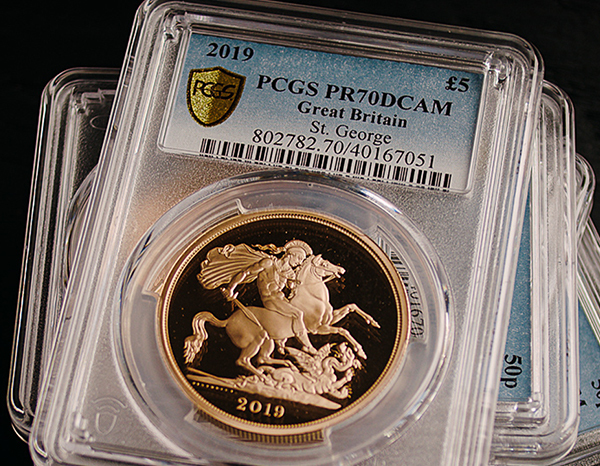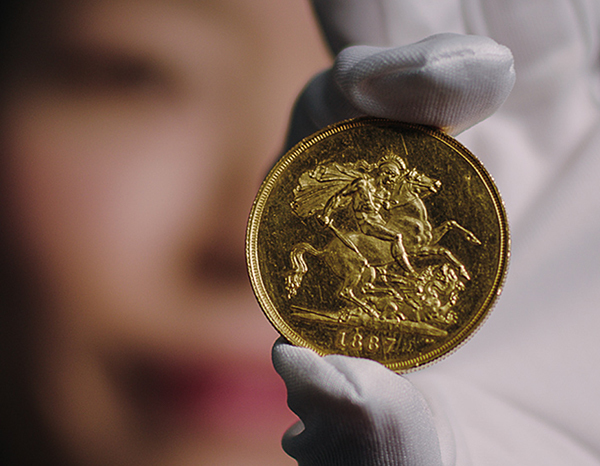Alloy
A combination of two or more metals.
Annealing
The heating (and cooling) of a die or planchet to soften the metal before preparation of the die or striking of the coin.
Artificial patina
The colour added by heat or chemical treatment. See patina.
Authentication
The process of determining genuineness.
Beaded border
Small round devices around the edge of a coin.
Blended
An element of a coin such as the date, design or lettering that has worn into another element or the surrounding field.
Brilliant
Untoned. With no tarnish or oxidation.
Brilliant proof
A particular type of proof coin that has a full mirror surface in the fields.
Brilliant uncirculated
A generic term for any coin that has not been in circulation.
Bullion
Ingots, coins, or other issues that trade for their intrinsic metal value, in silver, gold, platinum or palladium.
Bullion coin
A legal tender coin that trades at a slight premium to its value as plain metal.
Bullion value
The value given to a coin based on the precious metal it contains.
Burnishing
A process in which the surfaces of a coin are shined through rubbing or polishing.
Bust
A portrait depicting a figure’s head and shoulders.
Buyer’s premium
This is charged in addition to the successful bid. The Coin Cabinet offers the lowest transaction costs in the industry: 0% buyer’s premium and a maximum 10% seller’s commission on all auctions, a 10% total spread. Most auction houses operate on a 20-30% spread (the difference between the hammer price and what the seller receives).
BNTA (British Numismatic Trade Association)
An association formed by a majority of the leading UK coin dealers, founded in 1973. The BNTA organises the annual COINEX coin fair in London. The Coin Cabinet is a proud member of the BNTA.
Cameo
A proof, or proof-like coin with exceptional contrast between the fields and the devices. On a cameo coin, the fields are mirror-like, while the devices have a frosty appearance.
Carbon spot
A dark discolouration on the surface of a coin. If large enough, it might significantly lower the grade and value of a coin.
Cartwheel
An effect caused by the natural lustre on most mint state, and on some proof coins. When the coin is tilted back and forth, beams of light seem to circle the central devices of the coin.
Circulation
A term applied to coins that have been used in commerce. A circulated coin is one that displays wear, having been used.
Cleaned
When a coin has been cleaned with baking soda or other mild abrasives, it may have a slightly washed out appearance. Do not clean your coins! The original state of the coin — its patina — is more desirable to collectors than altered or damaged surfaces.
Coin/coinage
Metallic tokens of a composition and design that enables it to circulate as money. Coinage refers to a country’s issuance of coins.
Coin friction
Term applied to the area resulting when coins rub together in rolls or bags and small amounts of metal are displaced.
Collector value
Some coins are more sought-after than others. Their beauty, designer, and the popularity of the person or device are all examples of collector value. See Trend.
Commemorative issues
Coins issued to honour a person or thing, such as The Royal Mint’s ‘James Bond’ commemorative gold coins.
Commonwealth coins
At its height The British Empire’s coins were used extensively in global trade and as local currencies in its dominions, colonies, protectorates, mandates and other territories across six continents. Today’s Commonwealth is a political association of 54 member states, mostly former territories of the British Empire.
Complete set
A term for all possible coins within a series or from a particular mint.
Condition
The state of preservation of a coin.
Condition census
A listing of the finest known examples of a particular issue.
Contact marks
Marks on a coin that are caused by contact with another coin or a foreign object, usually small.
Contemporary counterfeit
A coin, usually base metal, struck from crude dies and made to pass for legal tender at the time of creation. Sometimes such counterfeits are collectable.
Counterfeit
An attempt to alter or imitate a coin with the intention to deceive or defraud.
Cupro-nickel
Any alloy of copper and nickel.
Deep cameo
Usually proofs with deeply frosted devices and lettering that contrast with the mirror fields.
Denomination
The face value of coin.
Design
The motif of a coin or other numismatic item, such as the sovereign’s iconic St George and the Dragon by Benedetto Pistrucci.
Design type
A specific motif placed upon coinage, which may be used for several denominations and subtypes.
Designation
An addition to the grade of a coin to denote characteristics of the coin not covered by the coin’s grade.
Device
The principal design element of the coin.
Die
A steel rod used to strike a coin.
Dipped
A coin which has been cleaned in a soapy solution. Dipping is rarely used, and only by experts.
Doctored
Typically considered a negative term. A doctored coin has been enhanced by chemical or other means.
Double-struck
A condition that results when a coin is not ejected from a die and is struck a second time. Proof coins are usually intentionally double-struck in order to sharpen their details.
Dull
A coin that lacks lustre.
Edge
The third side of a coin. It may be reeded, ornamented, or plain.
Edge device
Letters or emblems on the edge of a coin.
Elements
The various devices and emblems seen on coins.
Encapsulated
A coin sealed in a plastic holder, with its authenticity grading information displayed. The Coin Cabinet’s coins are primarily third-party graded coins, mainly by NGC and PCGS, who encapsulate the coins and warrant the grade. See slabbed.
Engraver
The person responsible for the design and/or punches used to craft a coin.
Environmental damage
Corrosion-effect seen on a coin that has been exposed to the elements.
Error
A numismatic item that unintentionally varies from the norm. Overdates and overmint marks are not considered errors since they were done intentionally.
Essay
Term for trial or pattern strikings, literally a test or trial.
Fiat currency
Coins or paper money that are not backed by a commodity such as gold. The UK abandoned the gold standard in 1931, while US President Richard Nixon cancelled the direct convertibility of the dollar to gold by 1973. Since then, a system of national fiat monies has been used globally, with variable exchange rates between the major currencies.
Field
The flat (or slightly curved) portion of a coin where there is no design.
Finest known
The best-known condition example of a particular numismatic item.
First strike
A coin struck early in the life of a die, with crisp detail.
Frost
An effect seen on the raised parts of a coin whereby the metal appears crystallised.
Guarantee
A pre-determined minimum selling price for a lot at auction, agreed between an auction house and seller. By agreement, The Coin Cabinet can guarantee a minimum amount for very rare items only (if guaranteed items end up selling below the guarantee, The Coin Cabinet will reimburse the difference).
Grade
The numerical or adjectival condition description of a coin. See NGC and PCGS.
Hairlines
Thin, shallow scratches on the surface of a coin, usually caused by improper cleaning or mishandling.
Haze
A cloudy film seen on business-strike coins and proofs. It may occur naturally or be added.
High Relief
A coin with deep concave fields, due to its design. High relief coins required extra pressure to be fully struck.
Hoard
A group of coins held for either numismatic or monetary reasons.
IAPN (International Association of Professional Numismatists)
An organisation of the leading international numismatic firms founded in 1951 and based in Geneva. Membership is by invitation only, and members must warrant the authenticity of coins for life. The Coin Cabinet is a pround member of the IAPN.
Intrinsic value
The value of the metal(s) contained in a coin. In the UK, coins contained 92.5% silver up until 1920, and after that were 50% silver. Since 1946, no British circulation coins have contained any trace of precious metal. See Fiat currency.
Investment grade
One step away from rare coins, investment grade coins are high quality and scarce, leading to strong investor demand.
Legend
Any phrase that appears on a coin. For example, Decus et tutamen (‘an ornament and a safeguard’) on the edge inscription of the British pound.
Loupe
A magnifying glass used to examine coins.
Lustre
The brightness of a coin that results from the way in which it reflects light. The grading process should determine whether the lustre of a coin is artificial, natural or diminished through wear.
Lustrous
A term used to describe a coin that still has its original mint bloom.
Marks
Imperfections acquired after a coin is struck.
Melt
Term for the intrinsic metal value of a coin.
Mint
A facility where coins are crafted. The Royal Mint in the UK is the second-oldest mint in the world still in operation, after the Monnaie de Paris.
Mint bloom
Original lustre that is still visible on a coin.
Mint set
A group of uncirculated coins from a particular year, usually comprising coins from each Mint.
Mint state
Describes a coin that has never been in circulation. Thus, the coin has no wear.
Mintage
The number of coins of a particular date struck at a given mint during a specific year. A mintage figure is the number of coins in all denominations minted and released into circulation.
Mint mark
Letter(s) or devices stamped into a coin to denote the mint at which it was struck.
Mis-struck
Term applied to minting errors, with irregularities.
Mishandled proof
A proof coin that somehow escaped into circulation.
Modern proof
Coins minted for coin collectors. The dies for making modern proof coins — see The Royal Mint — are often treated with chemicals to make certain parts of the design take on a frosted appearance, with the polished fields taking on a mirror finish.
Mottled
Splotchy, uneven patina.
Motto
An inscription on a coin.
New
Term for a coin that has not been circulated.
NGC (Numismatic Guaranty Corporation)
An authentication and grading agency based in the USA with offices in London. The Coin Cabinet is an authorised dealer with NGC, and uses NGC as part of its third-party coin grading service.. See grade, slabbed.
No-grade
Term applied to a coin returned from a third-party grading service that was not encapsulated (graded and packaged by a grading service). This can be due to questionable authenticity, cleaning or damage.
Numismatics
The science of money. Coins, currency, tokens, inscribed bars, and all related items are numismatic.
Numismatist
One who studies or collects money.
Obverse
The front (heads side) of a coin.
Off centre
A coin struck on a blank that was not properly centred over the anvil, or lower, die.
Original
Referring to any aspect of a coin that retains its original state.
Overdate
A coin struck from a die with a date that has one year punched over a different year. Often collectable.
Patina
The colouring which has formed on the surface of a coin as a result of the metal’s interaction with outside elements.
Pattern
A test striking of a coin produced to trial a proposed design, composition, or size. Patterns were often struck in metals other than the one proposed.
PCGS (Professional Coin Grading Service)
An authentication and grading agency based in the USA. The Coin Cabinet is an authorised dealer with PCGS, and uses PCGS as part of its third-party coin grading service. See grade, slabbed.
Plugged
Term used to describe a coin that has had a hole filled, often so expertly that it can be discerned only under magnification.
Population
The population of a coin refers to how many coins have been certified by a given grading service in that particular grade. The amount higher refers to how many have been certified in a higher grade by that grading service.
Premium quality
A term which describes the very finest coins that fall into any given grade, or that have some claims to a higher grade.
Presentation striking
A coin, often a proof or an exceptionally sharp business strike, specially struck and given to a dignitary or other person.
Press
A machine used to produce coins.
Pristine
Term describing coins in original, unimpaired condition. Pristine coins are typically graded 67 and higher.
Proof
The term proof denotes a method of manufacture, not a grade. Proof coins are made with special care, exclusively for collectors or investors and not struck for general circulation.
Proof set
A coin set containing proof issues from a particular year.
Prooflike
A coin that has mirror-like surfaces.
Provenance
The listing of a coin’s current owner plus all known previous owners. Also known as pedigree.
Questionable patina
Suspicious colour on a coin that may not be natural.
Raw
See ungraded.
Rare/rarity
The total number of extant specimens of a particular numismatic item. Condition rarity describes the number of specimens in a particular grade plus any in higher grades.
Reeded edge
Grooved notches found on the edge of some coins.
Relief
The height of the devices of a particular coin design.
Replica
A copy, or reproduction.
Restrike
A coin struck later than indicated by its date.
Retoned
A coin that has been dipped or cleaned and then has regained colour — either naturally or artificially.
Reserve
The reserve price is the lowest price for an item sold at auction, as stipulated by the seller. At The Coin Cabinet auctions, coins are priced without reserve at 10% below their bullion value, regardless of valuation.
Reverse
The back or ‘tails’ side, of a coin.
Royal Mint
The Royal Mint is a government-owned mint that produces coins for the United Kingdom, with a continuous history since 886 AD. In the past branch mints, such as the Melbourne Mint in Victoria, were established by The Royal Mint throughout the British Empire.
Rubbing
The barest trace of wear on the high points of a coin.
Scratch
A mark on a coin that is more severe than a hairline.
Semi-collectable
Refers to a coin that has a significant collector value and some bullion value.
Semi-numismatic
Coins whose value is made up by a significant proportion of precious metal, in addition to a collectable, or ‘numismatic’, premium. This represents a dual investment: the bullion value and the collectable premium.
Series
A particular design or motif used over a period of time. This can refer to a single denomination, or in some cases, several denominations.
Set
A collection of coins in a series. This could be a collection of types, or a collection from a particular Mint.
Sheldon scale
A system of grading which was originally introduced by Dr William H. Sheldon. The system was adapted to all coins in the early 1970s, and is used by NGC and PCGS.
Slabbed
Coins in a secure plastic holder with a statement of authenticity and designated grade by a third-party professional authentication and grading agency. Slabbed coins are becoming more common in the UK (it used to be a sign that a coin had been purchased in the US, where the large majority of coins have been slabbed since the 1980s). The Coin Cabinet sells primarily third-party graded coins, mainly NGC and PCGS who warrant the grade.
Sovereign
The sovereign is a British gold coin that was first introduced in 1489 by Henry VII and issued by every monarch who followed until early in James I’s reign. The sovereign was revived in 1816, featuring Benedetto Pistrucci’s St George and the Dragon design, which continues to be used today by The Royal Mint.
Splotchy patina
Colour that is uneven in shade and composition.
Spot
A discoloured area on a coin. A spot or spots can have a small or large effect on the grade of a coin.
Spot price
The current value of an underlying asset such as gold.
Strike
The sharpness of detail which the coin had when it was mint state. A full strike is a coin that exhibits the full detail that would appear on the sharpest known examples of that type.
Struck
Term describing a coin produced from dies and a coining press.
Struck copy
A replica of a particular coin made from dies, possibly but not necessarily meant to deceive.
Struck counterfeit
A fake coin produced from false dies.
Surface preservation
The condition of a coin’s surface.
TPG (Third-party graded)
TPG coins have been authenticated, graded and specially packaged (encapsulated) by an authentication and grading agency. The most commonly used and recognised are NGC and PCGS (The Coin Cabinet is an authorised dealer with both). Third-party grading plays an important role in the coin market, protecting the interests of both the buyer and the seller. See encapsulated; slabbed; NGC; PCGS.
Thumbed
Term for a coin that has been doctored in a specific way to hide marks.
Toning
Interchangeable word for patina. See patina.
Tooling mark
A line, usually small and fine, found on both genuine and counterfeit coins. They are caused by touch-ups to dies.
Transitional issue
A coin struck after an ‘official’ series ends, or before an ‘official’ series starts.
Treasure coin
A coin known to have come from a shipwreck or from a buried or hidden source.
Trend
Understanding the popularity of coins and how that correlates to collecting habits that might effect a coin’s collector value.
Type
A date or group of dates encompassing all of a particular standard design.
Ultra cameo
A term used, most notably by NGC, to denote proof coins that have deeply frosted devices and lettering that contrast with the mirror fields.
Ultra rare
A coin or other numismatic item that is represented by only a few examples.
Uncirculated
A coin or numismatic item that has never been in circulation, a coin without wear.
Ungraded
A coin that hasn’t been graded by an auction house, dealer or third-party grading service such as NGC or PCGS. See grade; encapsulated.
Used
Term used to describe a coin that has had light to heavy wear from circulation.
Variety
A coin that has characteristics specific to the die pair that struck it. Many collectible varieties can thus be traced to a specific set of dies.
Wear
Visible erosion of metal, usually beginning from a coin’s highest point. Eventually, lettering, details, or entire devices become illegible.




